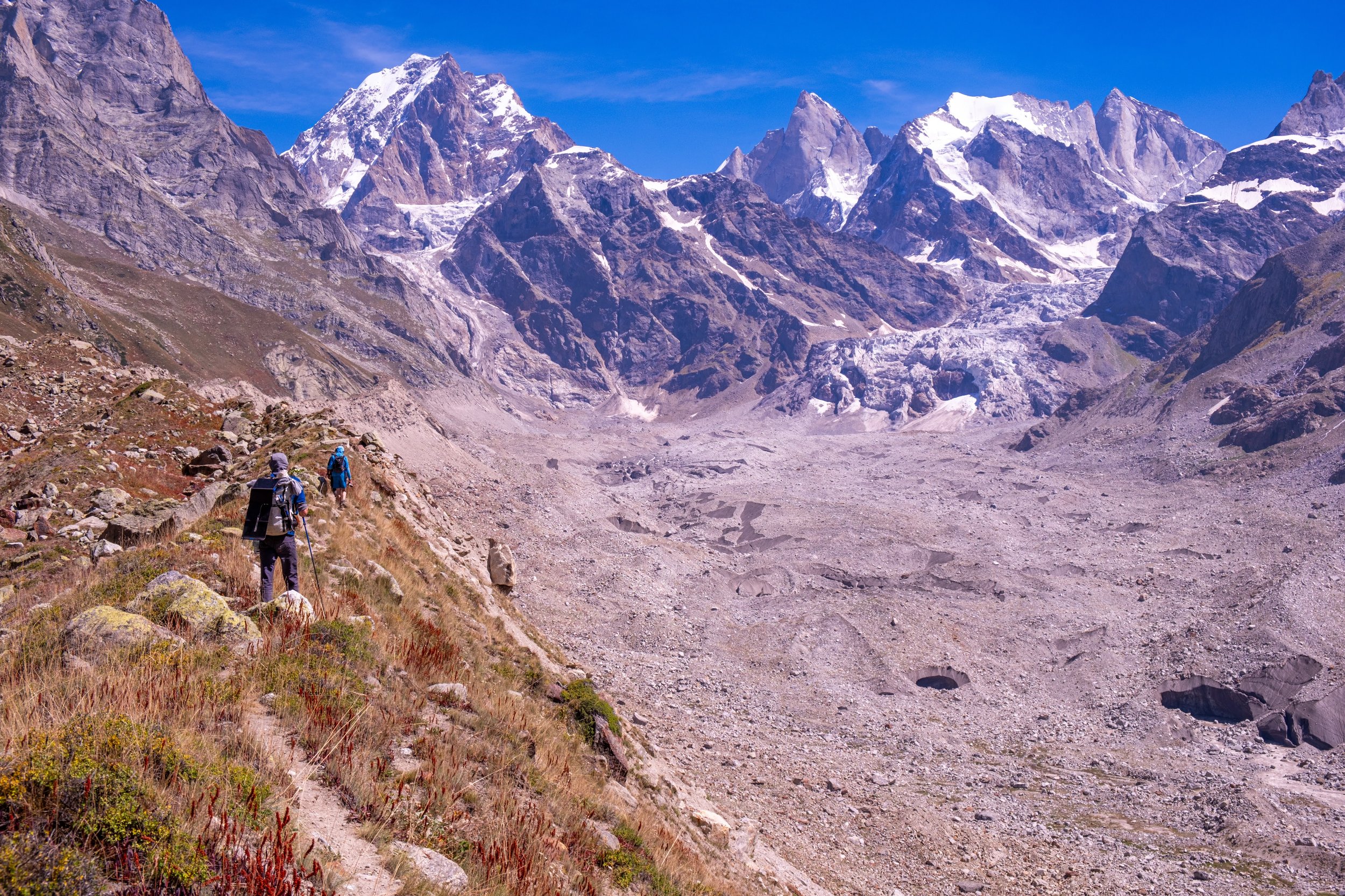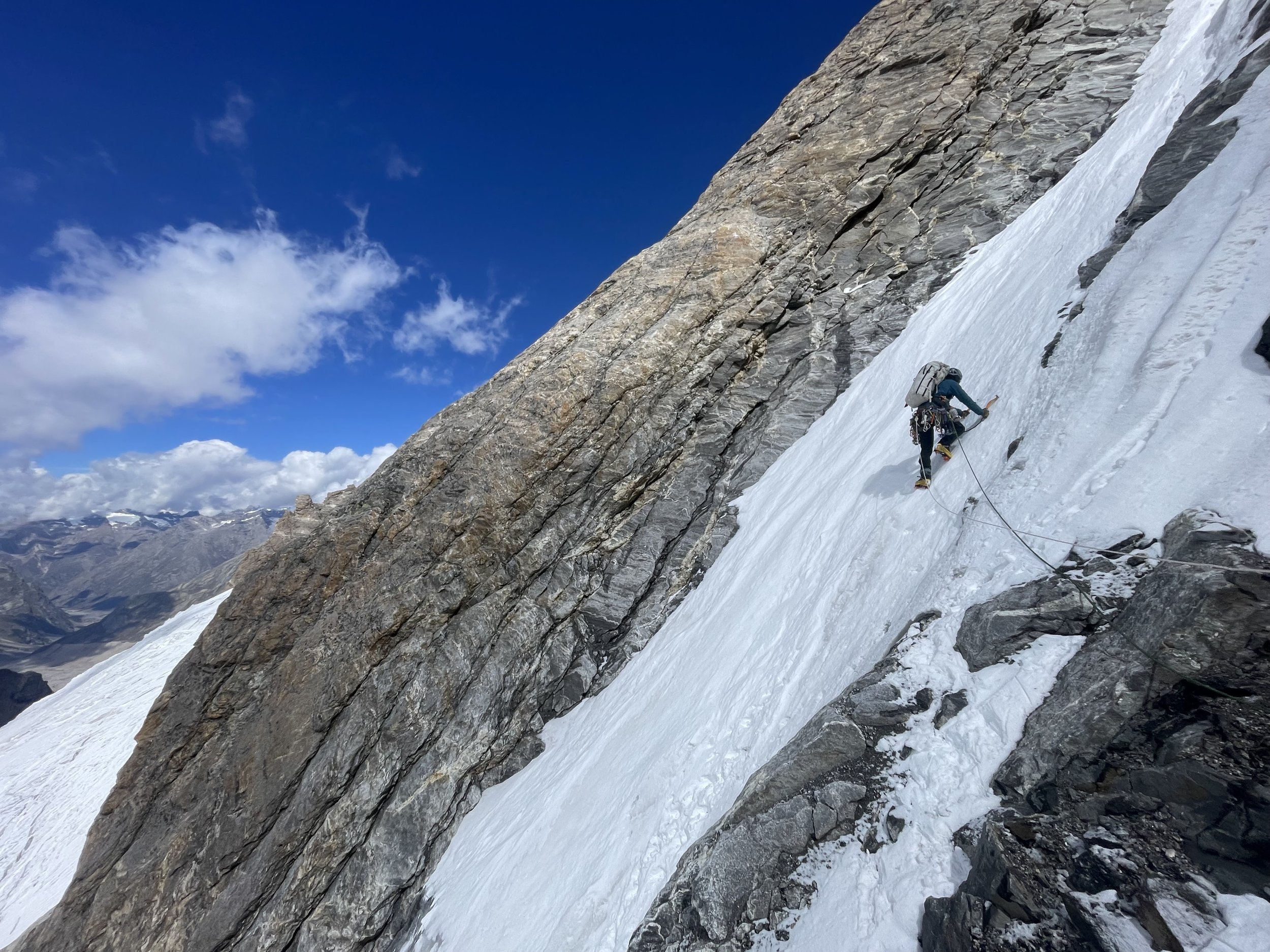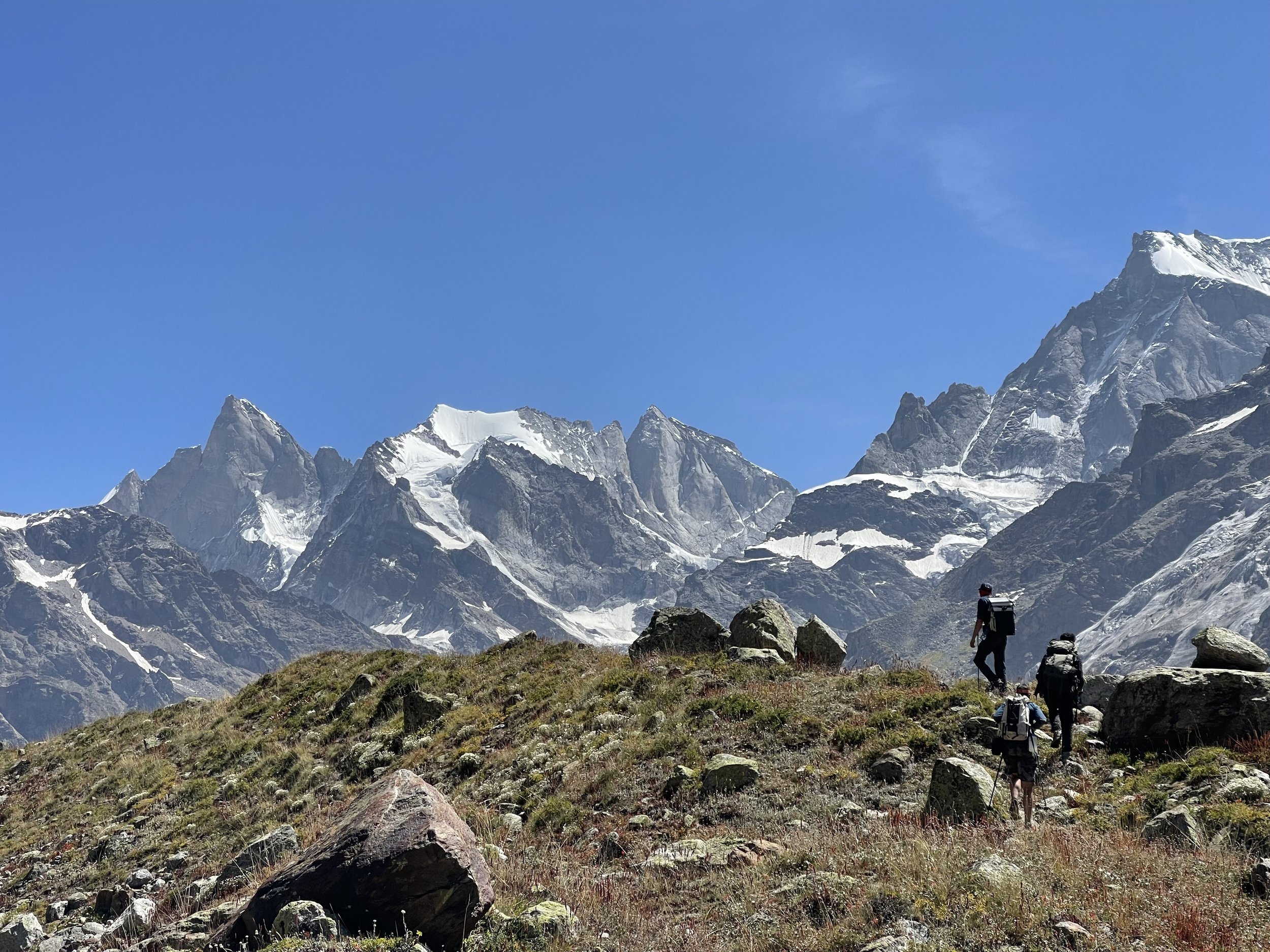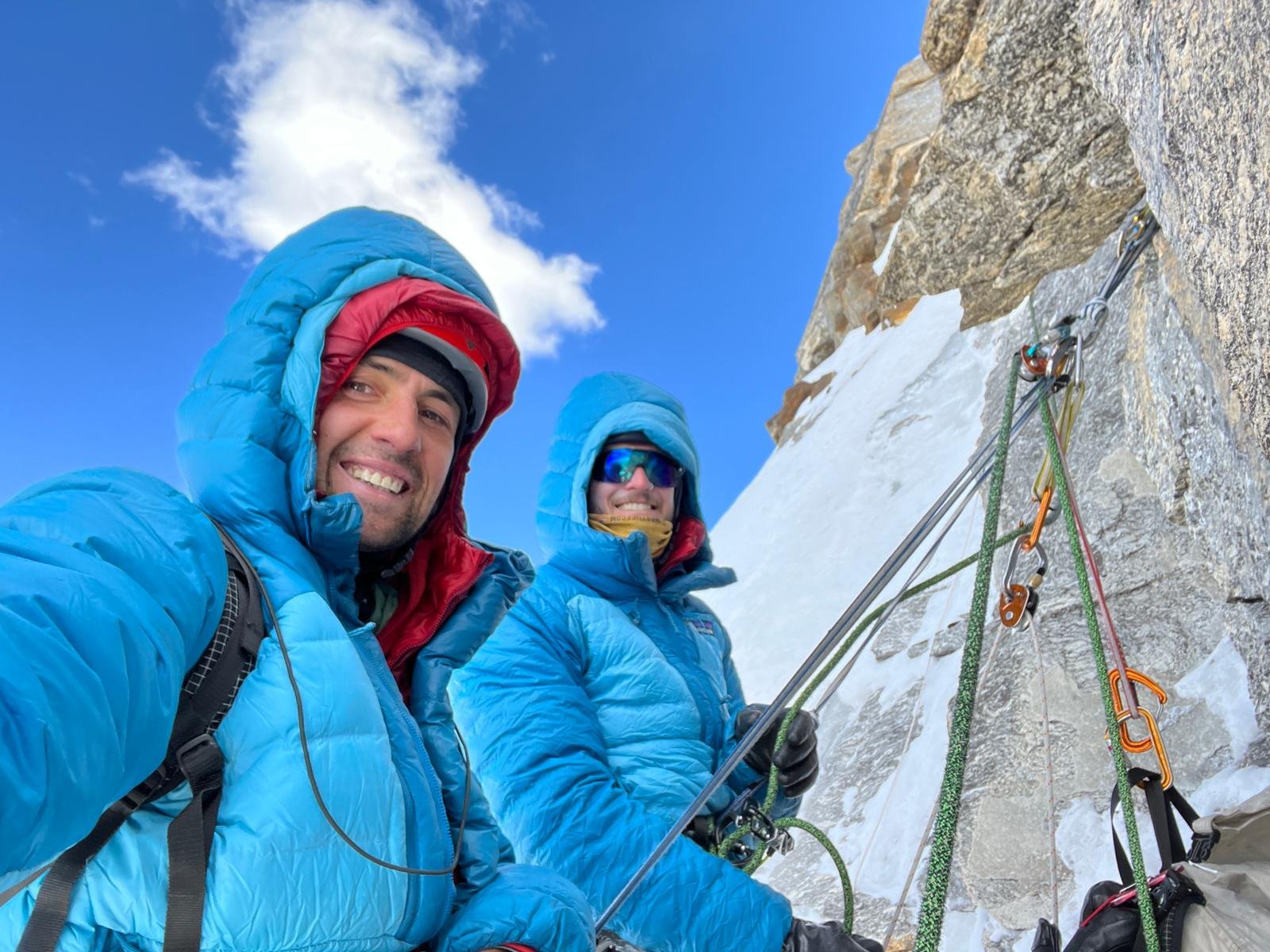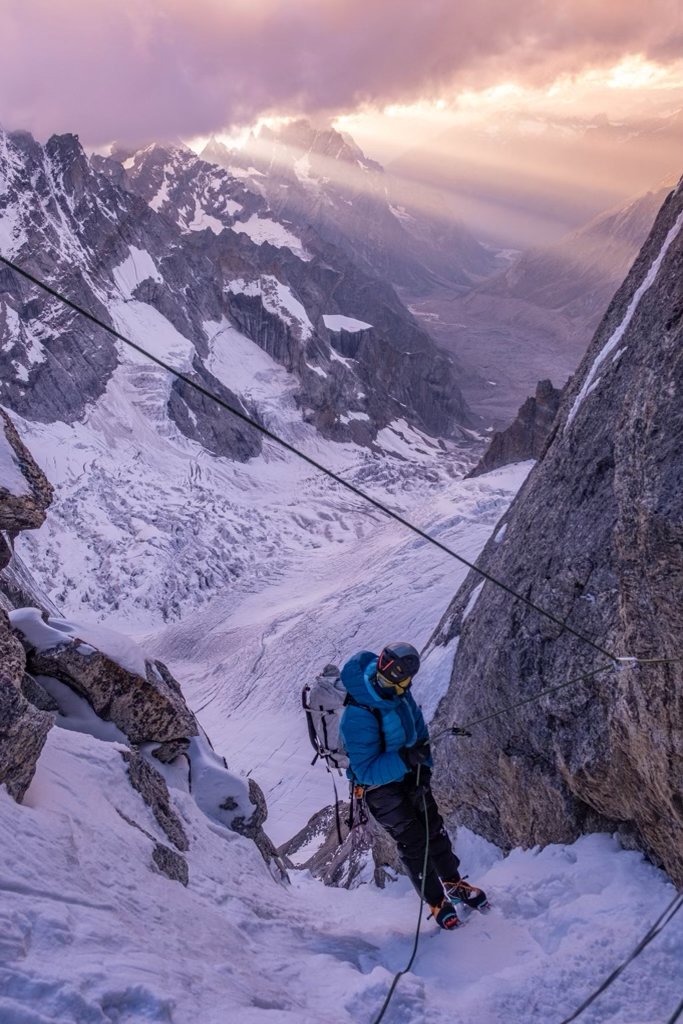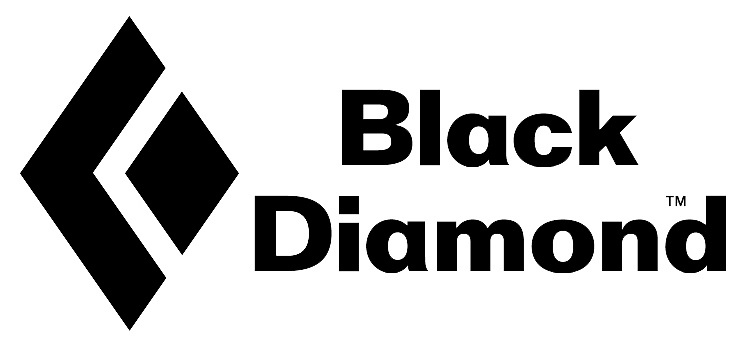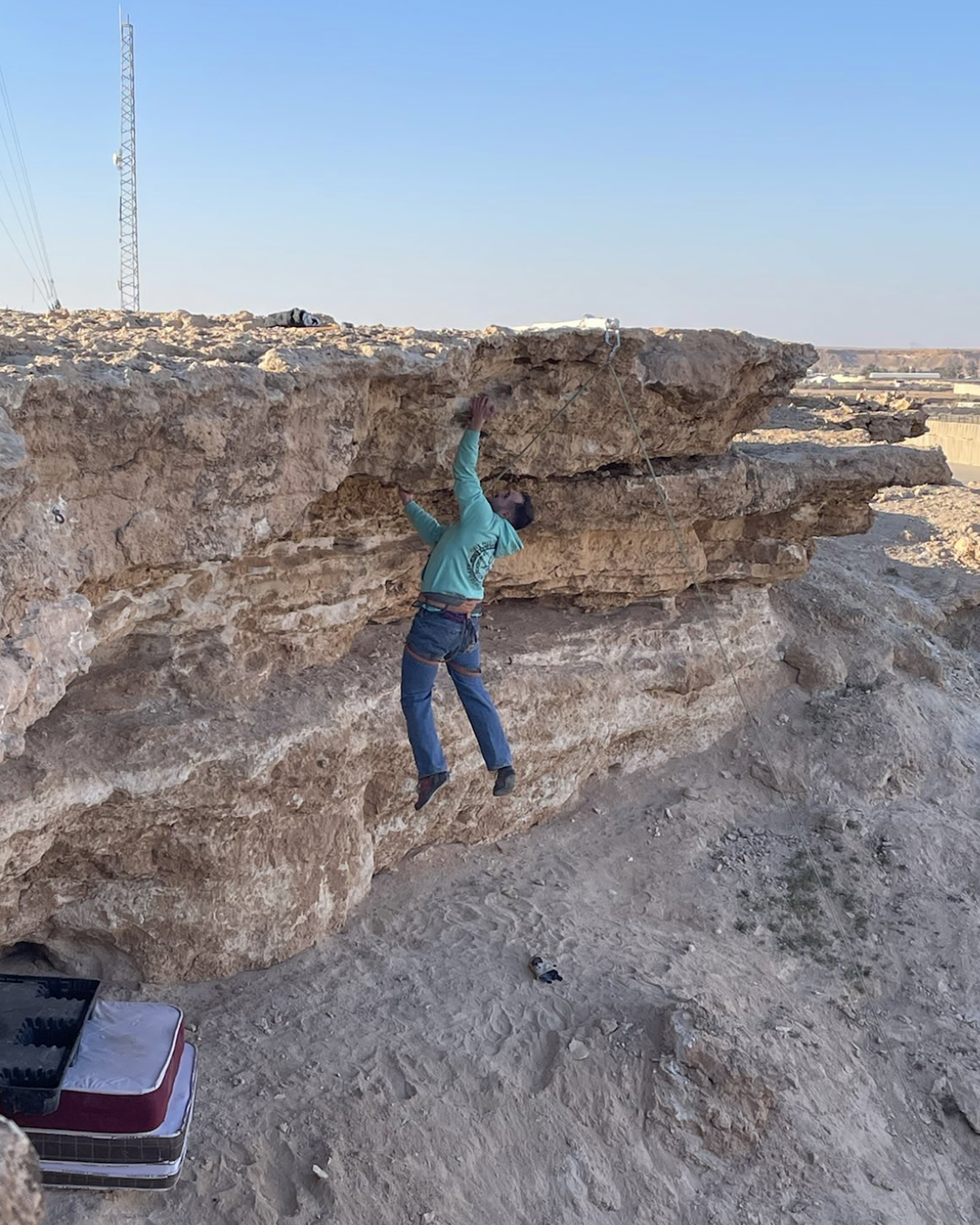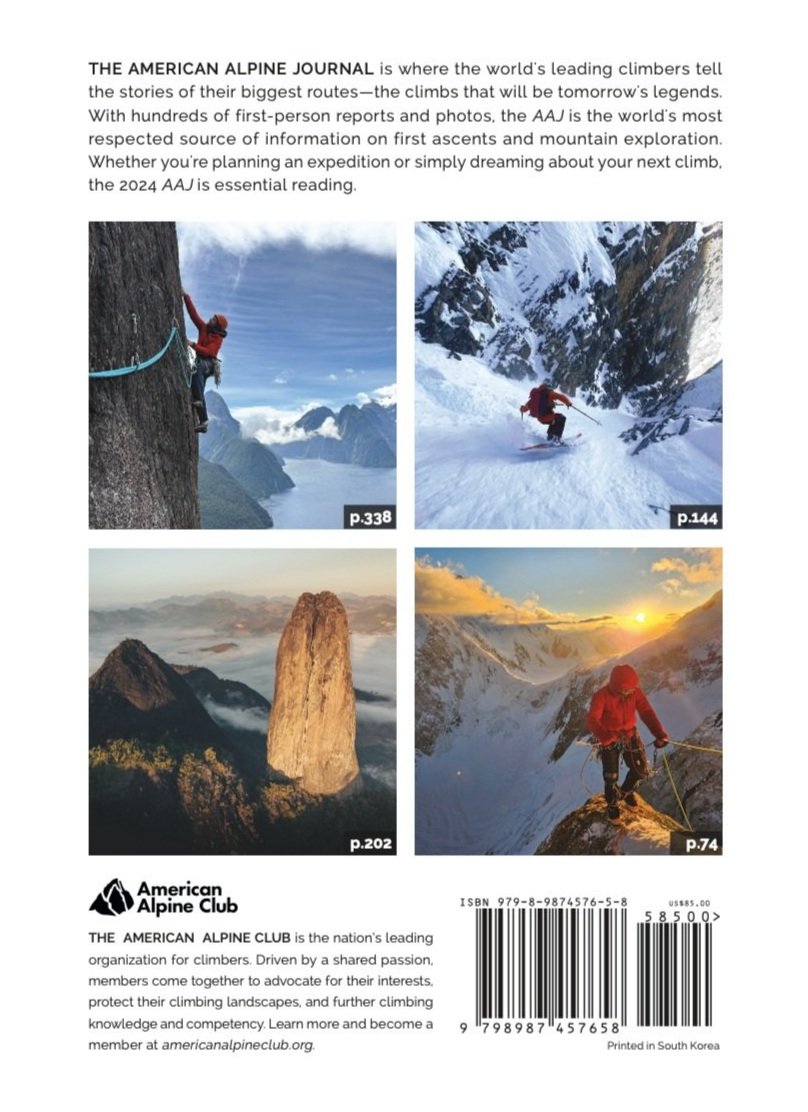Cerro Kishtwar (center), White sapphire (right). Photo by Vitaliy Musiyenko.
A Story from the 2023 Cutting Edge Grant
By: Sierra McGivney
On October 6, 2023, Christian Black, Vitaliy Musiyenko, and Hayden Wyatt summited White Sapphire, a 6,040m peak in India's Kishtwar Himalaya. The new route was named Brilliant Blue (850m, AI3, M7+). To attempt this mountain, the team received $8,000 from the American Alpine Club's Cutting Edge Grant, made possible by Black Diamond. They climbed the route free and in alpine style. This is the third ascent of White Sapphire.
Pack mules descending the valley on our hike to basecamp. Photo by Vitaliy Musiyenko.
AAC: In 2022, you received the Live Your Dream Grant to attempt a line in British Columbia on Mt. Bute. How did you transition from a Live Your Dream–style expedition to a Cutting Edge–style expedition in just a year?
Christian Black: The funny thing was we just needed an idea. Expeditions are challenging to plan. It all came from our friend giving us the idea—something to dream about, on the other side of the world as opposed to in America or Canada.
AAC: White Sapphire has seen two first ascents previously, via the west face in 2012 and the south face in 2016; how did you choose this peak and, more specifically, the line?
CB: I've always struggled to plan what to do in an area I haven't been to. There's just too much information out there. The story is that I met a guy who had spent his whole life going on expeditions. He had a whole list of unclimbed things he never got around to. He was trying to find people to do them. And he approached me and said: You're a big-wall climber with alpine climbing experience. You should check out this peak. I've got photos of it, and it's pretty cool looking. So, the original intent was to climb the big-wall rock face on White Sapphire, knowing that we had to be flexible to the conditions. We ended up climbing more of an alpine route because we went later in the season, and it had snowed and gotten cold. But to answer your question, it was a gift from someone who has done a lot of cutting-edge expeditions and is out of the game now. He had said: I'm aged out and happy to pass on the torch of ideas if you're interested in going to the Himalayas. The Himalayas are such a large place; you'll never know what to do unless you go once, so you just need a reason to go.
Hayden starting a simul-block up midway up the steep snow and ice of the lower section of the route. Photo by Christian Black.
AAC: Who gave you the idea?
CB: It was Pete Takeda [the editor of Accidents in North American Climbing.] I'm like a bad historical knowledge climber, so I didn't know much about him until later. But, I mean, obviously, he's legendary.
AAC: What type of climbing did you encounter on White Sapphire?
CB: We first encountered 2,000 vertical feet of steep snow and ice with moderate mixed climbing toward the top, anywhere from 60 to 80 degrees snow, and AI3 climbing. Then, it was more like M4 and M5 climbing to the top of the snow part. The upper headwall that goes up the direct north face of White Sapphire Peak ended up being a little over 200 vertical meters of climbing and seven or eight pitches of fairly sustained, steep dry tooling. And so there were about two pitches of M7+, a few of M6 and M5, and some alpine ice and snow mixed in.
AAC: How was the quality of the ice and the rock?
CB: It was really good. The rock up there is not granite; it's a gneiss. I studied geology, so I noticed, but you can't tell from far away. It forms cracks differently. It climbed quite a bit differently, but the rock was very solid. Except for one pitch, all the rock was pretty good.
AAC: Can you walk me through from when you left advanced base camp on October 5 until you returned on October 7?
CB: Yeah, so I might back up a bit because we had two attempts on the peak, the first one thwarted by a broken stove when we were 100 meters from the summit. It adds to the lore of the story. The moral of the story is the fuel mix in India is a little different, so it didn't work well with our stove and caused it to overheat. We learned a hard lesson about not taking a backup stove. That was our first attempt, but I'll fast-forward to the successful second attempt.
Starting to rappel from the notch after first attempt. Photo by Vitaliy Musiyenko.
We came down on that first attempt and had a few days at base camp. The weather looked like it would be good again, so we packed our food and some stoves and hiked up there. We waited about six days of weather for a good window to appear at our high camp. We left around three or four in the morning on October 5 from our advanced base camp at 15,800 feet. Then, we had a two- or three-hour glacier approach to the base. After that, we started simul-climbing the lower, less steep section of steep ice and snow. We did about a 1,300-foot simul-climb pitch. Vitaliy led that, and then Hayden led the second half of the ice and mixed climbing to the notch that day. We camped there that evening in our little corner bivy.
The following day, October 6, we woke up and took our altitude med concoction that gave us superpowers. What we had initially climbed as four pitches of steep mixed climbing the first time—we aided a lot of that and left in some of the crucial pins—this time, I suggested we climb it free. We ended up free climbing all of that terrain and didn't aid climbing anything. We did it in two 50-meter pitches. And that got us to our high point. From there, we continued to the summit. There was no terrain harder than those first two pitches. The headwall pops out directly on the small summit. We ended up being on the summit around 7:45 p.m. It was dark by that time of year, so we spent about an hour up there, melted some water, took photos, and enjoyed our time. Then we rappelled in the dark back to our bivy. The next day, we had a slow morning and rappelled back down to our base camp. It was an uneventful third day, which was nice.
AAC: What do you think was your biggest emotional hurdle on the trip?
CB: Oh, man, there were a few of them. A big one for all three of us was definitely the stove breaking on our first attempt. At that point, we were only ten days into our 26-day expedition and were 100 meters from the top. We thought it would be unbelievable if we did this first try. That would leave us with two weeks to climb whatever else we wanted. Accepting the reality that it was unsafe to go up without water was hard for us. We had less than a liter of water to share between three people, which would have been our ration for the whole day. Especially knowing now what the upper terrain is like, I'm super glad we didn’t go that first time. The climbing was still hard and would have taken a long time. Being dehydrated up there is not a safe thing that any of us would be willing to do. So that was a hard truth to accept.
Excited to be at notch bivy before sunset! Photo by Christian Black.
Luckily, the saving grace is that Hayden, Vitaliy, and I are all close friends. Vitaliy and Hayden didn't know each other before the trip, but I'm close friends with both of them. We all have very similar approaches to safety-related decisions. We were all on the same page about flexing the bail muscle. Other than that, we each had our moments of need, which the other two were naturally able to step in and take care of, which was nice.
AAC: How did you end up picking your team?
CB: Hayden is one of my best friends. We worked on the Yosemite SAR team together for a few years. I met him there, and we climbed El Capitan several times together. We just got along energy-wise. Over the past couple of years, we've gotten to go on multiple, more extensive trips together. One of those trips was to Mt. Bute on the Live Your Dream grant. This summer, we went to the Cirque of the Unclimbables for a month. If you're going to be in gnarly places, you want to be with good people. I only climb with my friends in those scenarios—honestly, in most scenarios.
Vitaliy, I met through messaging online. When I worked in Kings Canyon as a park ranger, he had put up a bunch of routes in the Sierra that I kept seeing his name on and was interested in doing. I messaged him to gather information. We ended up linking up on a climb the following year. We had an epic time. We did The Nose in a day as our first climb, and he took a 100-foot whipper. It was really scary, but we both reacted in a way that felt right. It built a lot of trust between us. Even though we haven't always lived in the same place, we'd casually link up for outings. We know each other as solid partners who know their stuff and are easy to get along with.
Photo by Christian Black.
AAC: That's great it worked out so well. It sounds like you had a good team.
CB: Yeah, that was the best part, for sure. You can't compare any experience to doing this with your two best friends. It's just so fun!
AAC: Do you have any fun anecdotes or funny moments from the trip?
CB: The funniest moments were just like how horrible we felt at various times. That is how we each process hard experiences in the moment. You can't help but laugh at it. And that's why we like each other as climbing partners, because none of us take it seriously.
A funny moment for me was when we made it to the bivy notch on the first attempt. It was pretty late, and I had fallen asleep multiple times on the last two pitches. We got up there, and I was boiling the water. It was dark, I was in every puffy layer I owned, and I was ten times more tired than I'd ever been in my whole life at 19,000 feet. I'm holding the Jetboil upright, and my purpose in life has never been more apparent. I hold the Jetboil. If the Jetboil isn't held, the water spills, and we don't drink water. I had an internal moment of reflection, like, wow, life has never been simpler than it is right now. There are only so many times when your life boils down to doing an incredibly simple task. For 45 minutes, that was my whole life.
The first mixed pitch out of the notch bivy. I'm [Christian Black] contemplating how to navigate the unprotected slab to gain the cracks. Photo by Vitaliy Musiyenko.
AAC: Is there anything else you want to add about the trip?
CB: The only thing I have to add is I feel so appreciative of a good team and good friends to be out there with and make hard decisions with. That was our biggest takeaway. We had a two-part goal going into the trip: A) we obviously wanted to come back alive, and B) become better friends. We achieved those goals through the roof. We have a lot of trust in each other. It's a cool medium to experience friendship in.
*Christian Black is writing a feature article for the 2024 American Alpine Journal about this expedition.

